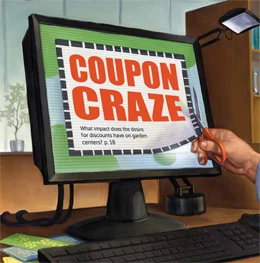 Ah coupons! The love/hate marketing tool used by garden centers everywhere! You love the traffic they can generate and hate the headaches that come with redemption. For better or for worse, these slips of paper aren’t going away anytime soon. In fact, the digital age and consumers’ newfound love of frugality have made coupons more relevant than ever. Ah coupons! The love/hate marketing tool used by garden centers everywhere! You love the traffic they can generate and hate the headaches that come with redemption. For better or for worse, these slips of paper aren’t going away anytime soon. In fact, the digital age and consumers’ newfound love of frugality have made coupons more relevant than ever.
Yes, couponing has hit an all-time high, according to a study by NCH Marketing Services. Here are some staggering statistics:
- Shoppers saved $3.7 billion in 2010, a $20 million increase from 2009.
- Marketers distributed 332 billion coupons for packaged goods in 2010, the largest quantity ever recorded in the U.S.
- The average coupon had a face value of $1.46, up 6.6 percent from 2009.
- 26 percent of coupons required the purchase of two or more items.
- 78 percent of consumers regularly use coupons.
Nothing new here
Kim Gaida of Dundee Nursery & Landscape in Plymouth, Minn., said their business model has been “coupon heavy” for many years. The strategy generally works well for them. But it’s not without difficulties. Recent media coverage of “extreme couponing” has shined the spotlight on coupon “stacking” and other methods to get a better bargain.
“This is not a new thing,” Gaida said. “Our customer had been trying to use multiple coupons for a long time. Our coupons do state that they cannot be used with other offers and one per customer.
“We do see some abuse of the coupons, especially the ones we post on our website—to a point, in fact, that we no longer post our best coupons on the website or hand extra ones out to our customers. And we have customers coming in as a couple, but will ring out separately so they can each use a coupon.
“We’ve seen our ‘$10 off any $10 or greater purchase’ get the most abuse—where I have had customers figuring out exactly what they can buy with it to get the most for the $10 and spend the 85 cents for tax. We actually had to refuse redemption from a customer who had been in five times last year, and we could track his coupon use with our loyalty program, which showed how many ‘one per customer coupons’ he had used.”
As tiresome as coupons can be, they at least offer some tangible evidence of whether a promotion was truly successful.
“We know a coupon is popular by the amount that we get back, how many extra we hand out, and how sick the cashiers are of seeing any particular coupon,” Gaida quipped. “Most are manual rings in our POS system. We have very few SKUs or barcodes attached to our coupons, so most are manual rings or hot keys in our system. We can’t track where they come from via the POS yet.
“All of our redeemed coupons are manually sorted and counted according to the delivery code on the coupon (postcard vs. insert). We then review their return rate and popularity at our spring recap meeting and fall planning meetings.”
Rise of the extreme couponer
Frugal consumers have a new role model these days: the extreme couponer. These bargain hunters have been popularized by media coverage, including the show “Extreme Couponing” produced by cable network TLC.
J’aime Kirlew is among the frugalistas profiled on the show. She also runs a popular couponing website, www.jaimekirlewcouponing.com, and lives by her “11th Commandment: Thou shalt not pay retail.”
Grocery stores and name-brand items aren’t the only things on Kirlew’s radar. Like many bargain hunters, she looks for deals at local establishments.
“I look for deals in every aspect of my purchasing,” she said. “It’s always fabulous to find coupons to my local retail stores. I make my garden purchases when the time is right: seasonally. I purchase what’s in season at the best price available.”
And while coupons aren’t the primary impetus for shopping locally, Kirlew said they certainly help persuade frugal consumers.
“I love to receive coupons from local, independent retailers,” she said. “I believe that in today’s ‘new economy’ savings are essential. I hope that local retailers see the benefit in offering a printable coupon from their website or a print coupon in a local circular.
“Couponers who run blogs like I do focus on posting coupons and deals available nationally and in our own local areas. Although it’s not a requirement for me to have a coupon to use at a local store, I would highly prefer it! It would get me in there frequently.”
Indeed, there is a growing and highly-networked group that is influenced by coupons. Many consumer brands, for example, are luring customers to Facebook pages with the promise of high-value coupons and free samples.
“Extreme couponers crave the use of coupons of everything we buy,” Kirlew said. “Although every extreme couponer may have a different method, we all agree that discounted is good, cheap is better, and free is best!”

Groupon grows
While retailers are grappling with the resurgence of traditional coupons, social-media-savings platforms—like Groupon (www.groupon.com)—have taken off.
Groupon relies on “collective buying power.” Site members receive details on a daily deal. If enough people buy into the offer, the deal “tips,” and becomes valid. If there aren’t enough takers, the deal is cancelled, and Groupon-ers aren’t charged.
Once folks are charged, they receive an e-mail with a link to sign in and print the Groupon. The Groupon has redemption instructions and a map right on it. Groupon members are also encouraged to refer friends and family, allowing them to earn credits on their account.
Groupon spokesperson Chad Nason said visibility is one of the primary advantages retailers reap when promoting through this platform.
“At our core, we’re a company that’s all about getting people out, and trying new things in their community,” he said. “You’re offering that discount to customers to bring them in, to try something new.”
Nason added that Groupon promotions reach three important groups.
“You reach regular customers,” he said, “and it’s like giving them a ‘thank you.’ You reach out to stagnant customers—those that haven’t been back—by giving them a reason to come back. And a large portion are the new customers. With other marketing opportunities, you don’t really have a way to gauge how they’re coming in. But when customers come in with the Groupon on their smartphone or a printout, there’s no question.”
Jury’s still out
Groupon has been a hot topic for garden retailers on online forums and message boards. Some, like Chalet in Wilmette, Ill., were pleased with the ROI gleaned from Groupon. Others, like Weston Nurseries (Hopkinton and Chelmsford, Mass.) didn’t get enough bang for their buck. Many others who’ve tried it are still trying to assess its effectiveness.
Rich Christakes, green-goods director for Alsip Nursery (Franfort, Ill. And St. John, Ind.), considered his store’s Groupon experiments a success.
“The most important thing to consider is your average sale,” he said. “We have done Groupon twice successfully, and planned on a third run this spring. We did ours at $19 for [a] $40 [purchase], and our average sale was $78 for Groupon redemptions. We got a lot of new customers and kept track of them with a spreadsheet at the registers.
“Also, not all who bought our Groupons actually redeemed them. (About 65 percent, and that was spread over several months.)”
Christakes said it helps to put Groupon into a larger advertising-expenditure-perspective: “Think about how much you spend to do any kind of advertisement,” he said. “Plus our website traffic was on fire both times. If you do it right it works great!”
Nason also advises retailers to have realistic expectations and—most importantly—be prepared for new traffic that results from a Groupon promotion.
“You need to prepare and make sure you have enough staff and product,” he said. “Make sure everyone knows how to handle the redemption. I think some of our merchants are surprised by how many people visit their store immediately afterward.”
Many of these Groupon-ers will be forming first impressions based on this visit.
“Make it count,” Nason said. “You’re getting a lot of exposure. Don’t just get through the rush. Create a positive experience. Make them say, ‘I want to go back!’”
Anatomy of a coupon campaign
 Kim Gaida of Dundee Nursery & Landscape in Plymouth, Minn., described the store’s coupon campaign, which forms the backbone of the company’s marketing strategy. Kim Gaida of Dundee Nursery & Landscape in Plymouth, Minn., described the store’s coupon campaign, which forms the backbone of the company’s marketing strategy.
“Our typical restrictions are that they cannot be combined with other offers,” Gaida said. “We can have our main coupons for discounts running in one place, and a second coupon for $10 off a $50 purchase in another small paper at the same time. One coupon per customer—but they do find ways to get around it. Coupon must be presented to receive discount. Retail sales only. It’s not valid on landscape contracts. Item must be of equal or lesser value. In-stock items only.
“All of our coupons have expiration dates on them, but we do honor them for a few days past to give good customer service.”
Dundee’s most effective coupons are…
Expo Weekend Discount. Targeted for the second weekend in April, this coupon is for 20-percent off the entire purchase for Saturday and Sunday only. It’s distributed via newspaper inserts and postcards.
“This is our spring kick-off weekend, and we don’t put this coupon on our website any longer due to abuse,” Gaida said. “We do have some extra that we hand out at the information counter, but they have to sign up to get our mailings and e-mail newsletters. It has reduced the people who come back multiple times to get the coupon.
“We also run some other unique coupons in the spring expo ad. These are our ‘comeback coupons.’ They have valid dates for April, May and June. When one offer ends, another one starts.”
$10 off a $10 or greater purchase. Dundee runs this coupon twice a year in newspaper inserts and postcards—once right before Independence Day, and a second one during their State Fair Sale (which runs the last week of August until Labor Day, coinciding with the Minnesota State Fair).
“We call it our ‘corn dog coupon,’” Gaida said. “Get it? To go with all of the fair food that comes on a stick! This one, again, is not on the website and is handed out at the information counter only in a limited number, and they have to sign up for mailings.”
Customer Appreciation Weekend. This is usually valid the second-to-last weekend in September, again distributed via newspaper inserts and postcards.
“We have two great coupons,” Gaida said. “The best is a coupon for 50-percent off any one item—regularly priced. The second is for 20-percent off your entire purchase. These can both be used in the same transaction, but the customer will get one item at 50-percent off and the rest at 20-percent off—they can’t get another 20-percent off of 50 percent.”
“The 20-percent off coupon is handed out at our information counter to a limited extent, but the 50-percent off we stopped handing out a few years ago. These coupons go along with our customer appreciation events that are running that weekend as well. We have a lot of things going on Saturday, and some workshops on Sunday.”
|

 Ah coupons! The love/hate marketing tool used by garden centers everywhere! You love the traffic they can generate and hate the headaches that come with redemption. For better or for worse, these slips of paper aren’t going away anytime soon. In fact, the digital age and consumers’ newfound love of frugality have made coupons more relevant than ever.
Ah coupons! The love/hate marketing tool used by garden centers everywhere! You love the traffic they can generate and hate the headaches that come with redemption. For better or for worse, these slips of paper aren’t going away anytime soon. In fact, the digital age and consumers’ newfound love of frugality have made coupons more relevant than ever.


 Kim Gaida of Dundee Nursery & Landscape in Plymouth, Minn., described the store’s coupon campaign, which forms the backbone of the company’s marketing strategy.
Kim Gaida of Dundee Nursery & Landscape in Plymouth, Minn., described the store’s coupon campaign, which forms the backbone of the company’s marketing strategy.





